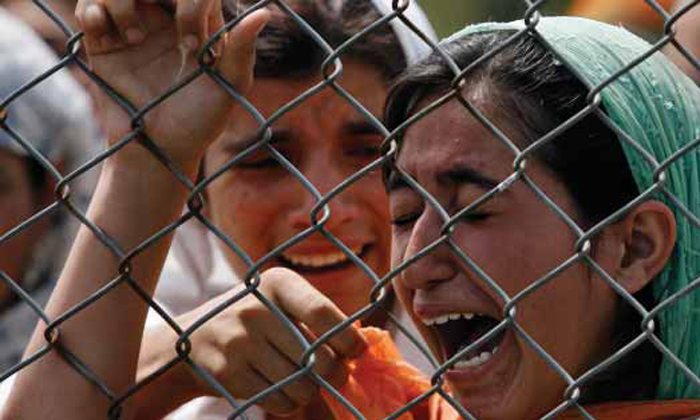In the summer of 2010, the response to Kashmir’s anger erupting onto the streets was not just brutality but also an Indian nationalistic narrative claiming that the stone pelting mobs were sponsored by militants. In 2012, as Kashmir braces for another summer, in the intervening period marked by the invisibility of anger, a fresh narrative has taken over – that Kashmir is moving on or must move on. The source of the 2010 narrative was official circles; the 2012 narrative emanates from Indian intelligentsia who are busy manufacturing consent about ‘anger transforming into optimism’. The arguments may sound new but are a morphed version of the traditional paradigms of ‘normalcy’ and ‘peace’ used in the past. Even during the peak militancy years, when local Doordarshan channels would broadcast news, the scorecard of daily violence and casualties always ended with the one-liner: ‘However, there was complete normalcy across the rest of Jammu & Kashmir.’
“The Valley today is not just a place awaiting an estimated influx of 2 million tourists, or where people voted en masse in panchayat elections, it is also a place where issues of justice have been buried forever.”
Now, as the government decides to maintain a cryptic silence, after vain attempts by parliamentarian groups and Kashmir interlocutors to feel the pulse of the youth, it is the jargon of intellectuals that has taken over. Everybody is keen to reinforce two points – that Kashmiris must move on and that they are happy – trying to drive home a theory of ‘the existence of peace’. The official exercises after the 2010 agitation, it is now clear, were not meant to address Kashmiris, but were for the purpose of creating camouflage and constructing an image of Kashmir that may not be agreeable to its people. Among the supporters of such theories are former RAW chief A.S. Dulat and former chief information commissioner, Wajahat Habibullah, both drawing their conclusions from the prevailing calm and flourishing tourism, inferring that people of Kashmir have a stake in this ‘existing peace’ and thus that ‘they must move on’. Dulat even claimed that Kashmir in this backdrop of ‘normalcy’ can be solved ‘overnight.’
But just how does one move on? The Valley today is not just a place awaiting an estimated influx of 2 million tourists, or where people voted en masse in panchayat elections, it is also a place where issues of justice have been buried forever. How do those who lost their sons and daughters during the 2010 agitation move on, without the government even trying to investigate the cases? How do Kashmiris collectively move on when public campaign against the Shopian rapes and murders of 2009 was met with such apathy and attempts at cover-ups? How do they move on when the country’s apex court, the last hope of Kashmiris in the Indian legal justice system, recently directed the Army to deal with the guilty in the Pathribal fake encounter case, in which they were accused of kidnapping and killing innocent men and then passing them off as foreign militants for promotion and reward? How does one expect victims of human rights abuse, having been wronged by official security agencies and then denied any form of legal justice, to just forget the past and move on in pursuit of a peace that is a mere façade? While the Indian intelligentsia is sketching rosy pictures of flourishing tourism and optimistic youth, the government is on its toes executing crackdowns and effecting large scale arrests and detentions in fabricated cases of what is called ‘Facebook terror’. Atrocities and happy tourists go side by side; peacefully coexisting in a Valley defined as ‘normal’ and ‘peaceful’ when in fact, even the most mundane of protests over development issues and jobs have been met with brute force – from water cannons to point blank firing – resulting in more deaths. Each and every protest is scuttled as if the fundamental right to protest has been scrapped from the law books.
The Indian intelligentsia draws some support locally. Recently, a newly evolved youth group organied a mega event called ‘Kashmir Next’ to draw a vision of future by discussing issues like water, economy, development, eco-tourism and art, without even a murmur about political dispute, discontent or the human rights scenario. It could well be seen as an attempt to brainwash the youth into learning to live in inhuman conditions and an unjust polity while making the best of whatever is left – culture, environment, employment and women. The vision agenda was defined as an attempt to ‘shed away the gloomy veil’ and to call upon the youth to rise and live with dignity. Yet skirting basic issues removes no gloomy veil and only amounts to adding yet another layer of glamour to hide the ugliness beneath. As for the hype about dignity, one cannot see any space for that without basic civil rights, which were not even spoken of. How are the youth expected to rise? By turning their backs to ground realities and talking about a healthier environment and good cultural sense or even better education? Besides, where is the space for the youth to act independently? The moment you talk politics, repressive measures of the State crack down on you! (One of the organisers did admit that out of fear of reprisal from the government, they deliberately avoided the core issues as a theme but were hoping that participants would raise it). This selective vision was projected as a holistic one; there is little logic in the entire exercise. Less than a year ago, some of the local intelligentsia collaborated with Indian litterateurs to host ‘Harud’ literary festival that was described as an ‘apolitical’ event in the Valley. Following protests on a social networking site and a signature campaign, they chickened out, blaming the signature campaign for creating terror. The letter had raised a pertinent question about the purpose of holding such an event in a place where basic fundamental rights are absent and denied and yet could not be discussed since the event was deemed ‘apolitical’. “We fear that holding such a festival would, willy-nilly, dovetail with the state’s concerted attempt to portray that all is normal in Kashmir,” the letter mentioned. These fears are not misplaced. There is always a method to such madness and one wonders if this bit of insanity is being scripted somewhere; one cannot rule out that this is by design, with the local collaborators and their mentors in New Delhi working in perfect synchronisation.
An article by journalist and writer, Manu Joseph, concluding that ‘Kashmir is happy’ is yet another pointer. Manu Joseph comes to this conclusion by observing tourist spots brimming with tourists and happy boatmen, coffee shops where young people sit and chat endlessly, and the many who are now opting for Indian Civil Service examinations. This, according to him, means the whole of Kashmir must be happy! Did he visit homes shattered by the conflict? Did he see the dismay of the families of boys killed in 2010, struggling for legal justice and still unable to cope up with their loss? Did he observe the families of the people who disappeared in custody gathering every month at a park in Lal Chowk Srinagar, just a stone’s throw away from where he sat sipping coffee and watching blissful youth re-emerging, to share their tales of dismay and talk about their resolve to carry on the struggle to know the truth despite the complete inaction of the government? Had Manu Joseph visited one or two such homes and found them chuckling over trivial matters, it would have been a successful litmus test for him to judge their happiness.
Happiness is a state of mind and cannot be judged by few distant glimpses of another being. Kashmiris are basically warm people with a sense of humour that has been a powerful tool of survival in the last two decades of armed conflict. It should not be a wonder if people in strife-torn Kashmir are moving about their normal lives, cracking a joke or two, or occasionally smiling. Such mundane things reveal nothing about hope or despair, happiness or grief.
While I was writing this article, my nine-year-old daughter asked me what I was writing about. “I am writing about whether Kashmiris are happy or not,” I told her. “What kind of question is that?” was her perplexed response. “Someone from Delhi visited the Valley and said that Kashmir is a happy place.” It didn’t take her a minute to blurt out, “So, have they got their rights, now?” “No,” I said. “Then how can they be happy?” she reasoned. “Because this visitor saw them going to restaurants, picnics…” I began and my fuming nine-year old interrupted, flailing her hands in air, “So, So… if people are sad, should they give up everything they enjoy? Should they stop eating, breathing…?” Perhaps Manu Joseph should have asked a few nine-year-olds what they felt about the present calm; he may have had a different experience and view, rather than the oversimplified black and white formula of good or bad, happy or sad. Why must anybody have the right to decide the kind of happiness another person enjoys in the first place, and what is a barometer for happiness?
It is difficult to believe that this new narrative thrust on Kashmiris is something that stems from ignorance. There are signs of an evident design that suits the government and lends support to its slogan that Kashmir reposes faith in Indian democracy and Indian institutions, and relieve itself of the task of democratising Kashmir in the real sense of the word. At the same time, there is a clever ploy to put the entire onus on the youth of Kashmir, both to blame them for the mess and expect them to clean it up. Convenient! Because despite this smokescreen, even they know that the present calm does not translate into optimism. It is more a reflection of fatigue, and once anger, which always has its own gestation period, erupts again, it would be convenient to blame the youth.














